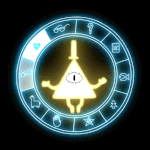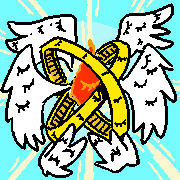|
oriongates posted:They should double down on the animal weaponry. Literal swordfish, lemur-chucks, throwing ferrets, snake knuckles! 
|
|
|
|

|
| # ? Apr 26, 2024 08:57 |
|
Bear arms.
|
|
|
|
Cat armor This image was harder to google than you might expect.
|
|
|
|
 Mythender Part 6: Corruption, Death, and Gifts We discussed the process for Corruption last time, but as a review: When you take a Mythic or Titanic action, your Mythender is corrupted by their Mythic Heart. After each such action, you check off a Corruption box: 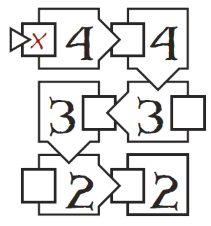 Then you check the Mythic Die’s result. If you rolled equal to or higher than the number in the Corruption box, you need to check off a row in the Fate track. Should you have a result less than the number, you can also elect to progress the Fate track regardless. Since the Fate track also acts as your Gift slots, this can be advantageous if you want more special ability options. Note that the first (topmost) row is permanently starred; it holds a Mythender’s starting Gift. 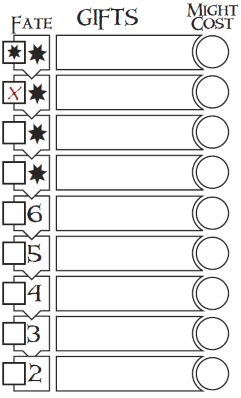 Any open Gift slot can be filled at any time, including immediately before such a gift could be used. For example, an open slot could get filled just after you take a wound- one Gift, Bloodlust, gets more powerful if you just lost a lot of Thunder dice from a wound, so you could immediately take that gift even after rolling the dice. If you run out of rows and would need to fill another, you can still use a single new gift during your action, but it goes away as soon as your turn is over. Note the numbers on the lower rows. At the end of a fight, and only then, anyone that has a row with a number checked off will roll the Mythic Die. If the result is at least the number in the bottommost checked row, then your Mythender undergoes Apotheosis. This is generally a bad thing. quote:If you’re out of unchecked Fate boxes, for one, you’re pretty much hosed at the end of this Battle. It’s unlikely you’ll come out of it still mortal. Yup. That 1 in 6 chance ain’t great. If a Mythender dies, they can choose to stay dead. They’re out of the fight, and so is their player. Alternatively, as often mentioned previously, they can choose to resurrect themselves. In doing so, they progress their Corruption and Fate tracks by one, then make the first non-permanent box in the track permanent (circled). There is no way to roll the track back beyond that point. You can corrupt yourself and resurrect as many times as you like, even if you’re out of boxes on either track- you don’t die permanently unless you so choose or the Myth’s doom timer comes up after the fifth round- more on that later. If, at any time, you check both Corruption boxes in the first row, your Form changes from mortal to Paragon. The next two rows do the same for your Supernatural and Godly forms. You fill these in at character creation, and they show off your greater power and determine your starting Thunder die, both at the beginning of a battle and when you come back from death. Those in their Mortal form gets 1 Thunder die, Paragon 2, Supernatural 4, Godly 8. Lesser Myths start with 2-4 Thunder Dice, Greater Myths have 6-8. There’s a few summaries of combat here, but we’ll effectively get those when we look that their tutorial battle. Instead, let’s look at the Gifts: There’s only 18 of them, so I suppose I’ll go over them all. If you glaze over at ability lists, suffice it to say that it’s a whole bunch of dice tricks, modifiers, and bonuses to token generation. Some want you to add special description, but really the gifts just there to add a bit of strategic garnish to your pile of numbers. They’re organized alphabetically, but I’m going to split them up into two sets of my devising: Universal and Specialist. Universal Gifts can be useful to everyone just about anytime, the rest are pretty situational. Most of them have Might token costs, paid each time they are used. Some also have upgrades with dumb names that I will ignore; these upgrades cost another full Gift slot. Some are also locked to either Mythenders-only or Myth-only. Any “Aiding” upgrade allows you to use that Gift for allied Mythenders’ actions. Gifts can only be used as part of an action unless marked with “non-action.” Universal gifts:
Specialist gifts:
My personal favorite combo for the Myth is using Focused Onslaught, Building Doom, and heavily upgraded Sureness. The Myth can easily be getting dozens of Thunder dice near-guaranteed, plus piles of bonus dice, if the Mythenders don't take down Blights quickly. Takes a shitload of Might to use, though. There's then a page on building your own Gifts, with suggested costs, but a lot of cautions on what systems are more likely to break the game balance. If you make something that everyone would take immediately, it's probably too useful or cheap. Relentlessness is called out as a good baseline cost, being 2 Might for a reroll of all failures in a pool. Some areas suggested are alternate action Effects, like Viscous Denial. In my first game, I ended up including a Gift called Indomitable Haste that let you pay 2 Might to immediately roll any Thunder dice gained from your Storm dice. This lets you snowball a little more quickly, and the early Lightning stock it provides stacks well with Gifts like Master Tactician that let your allies cause effects more often. Overall, if you like using the dice manipulation charms in Exalted, Gifts are your playground. And if you're playing this game, that's likely the case. Next time: Non-combat mechanics, which somehow also include murder (twice)
|
|
|
|
oriongates posted:Cat armor there's a whole series of 'old man wearing cats' from the same artist, good luck finding them as the last time I saw them was on a 'booru
|
|
|
|
Robindaybird posted:there's a whole series of 'old man wearing cats' from the same artist, good luck finding them as the last time I saw them was on a 'booru I'm pretty sure that guy has a Pixiv account. Edit: Here you go.  Young Freud fucked around with this message at 03:29 on May 27, 2018 |
|
|
|
He does seem to have decided that buff old men and cats are basically all he cares about and gently caress anyone who disagrees. Shine on you crazy diamond.
|
|
|
|
oriongates posted:He does seem to have decided that buff old men and cats are basically all he cares about and gently caress anyone who disagrees. Shine on you crazy diamond. 
|
|
|
|
Mr. Maltose posted:I don’t think it’s drawing from like, a single specific source, but bees have been symbolic of order for a long rear end time so it’s not the biggest leap to make. They build highly-structured honeycombs. Not a big jump from that to building mystical structure.
|
|
|
|
For those of us in the UK, Spire is now available from the Rowan Rook and Decard website. UK-based shipping!
|
|
|
|
potatocubed posted:For those of us in the UK, Spire is now available from the Rowan Rook and Decard website. UK-based shipping! That shipping is a little better than IPR, nice. (About $15 cheaper to Canada.)
|
|
|
|
potatocubed posted:For those of us in the UK, Spire is now available from the Rowan Rook and Decard website. UK-based shipping! Aren't they selling this in London? Though Orcs Nest is closed till Tuesday.
|
|
|
|
potatocubed posted:For those of us in the UK, Spire is now available from the Rowan Rook and Decard website. UK-based shipping!
|
|
|
|
It would be nice if there were pictures of the luxury accoutrements on the site.
|
|
|
|
Subjunctive posted:It would be nice if there were pictures of the luxury accoutrements on the site.    
|
|
|
|
gently caress me I’m about to spend $100 on an RPG book.
|
|
|
|
Subjunctive posted:gently caress me I’m about to spend $100 on an RPG book. 
|
|
|
|
Sure does.
|
|
|
|
Subjunctive posted:gently caress me I’m about to spend $100 on an RPG book.
|
|
|
|
 Mythender Part 7: Non-combat mechanics, which somehow also include murder (twice) After battle concludes and players roll for Apotheosis, the Mythenders rest and get to explore the world a bit. This time is used to flesh out characters' motivations and prepare for their final fight, along with providing some contrast in tone so the action scenes have a point of comparison. Each player gets at least one Moment in which to do so, and certain rules govern any events that relate to one's Mythic nature. If their Moment is something mundane, there’s no particular rules- arguing with a mortal, going to the market to get a quick bite, going fishing, and other tasks are explicitly noted as being outside of the rule system. You’re free to roleplay out as much or as little as you like, but if it stops being interesting, the book wisely notes that you should just cut to the next Moment or battle. Small, mundane moments can lead into bigger Moments, if such a thing is desired- the example given is that a Mythender gone fishing could then ask the Mythmaster for the “King of Fish” to show up, which falls under the Performing a Badass, Epic Feat sub-Moment. There's two primary Moments, "Terrorizing Mortals for Power" and "Seeking Sympathy and Healing." If a Mythender is drawing power from their Mythic Heart for any reason, it falls under the Terrorizing Mortals for Power rules. The Mythender may not be “terrorizing” them in the sense of actually threatening mortal lives, but they are doing something that could inspire worship. Even “acts of kindness fueled by Mythic power” can qualify. After roleplaying out the Moment, you check off two Corruption boxes, which will change your form and should be incorporated into your description, and roll the Mythic die. Results of 4-6 result in a double advancement of Fate, else one advancement. Then you gain Might equal to the Fate boxes currently checked. This gives you a pretty large boost to the beginning of the next combat. If a Mythender instead wants to back off from Corruption and thus must try to show mortals that they are still a person deep down, then it falls under Seeking Sympathy and Healing. If you wish to do so, Fate will provide an opportunity- as in, the Mythmaster will work with you to contrive such a situation. You’ll then roleplay it out up until you ask whether the mortal sees you as a horrible Mythic storm of power, or else a person. At that moment, you consider the following questions:
There’s a few variants of these two primary Moments: Performing Badass, Epic Feats: If your godlike physical and mental abilities, Weapons, or Fate Powers (like being fated to become a God of Healing) would allow you do something supernatural, you can do so to gain power. As with combat actions, you succeed at performing the Feat, with no roll for that part. You can either embrace your Corruption, in which case the Moment is Terrorizing Mortals for Power, or resist Corruption. If resisting, you make a roll, and have about a 1/3 chance to succeed and thus avoid having to do Terrorize. If you fail, you must Terrorize and it gets you only 1 Might token regardless of the result. You can also pay some Might to create or destroy a Blight. Embracing Corruption allows you to do as much Blight creation or destruction as you can pay for, including the Might you got from Terrorize, while resisting can at most only create one Blight or destroy one Blight. Helping Mortals: If you’re using your power as a Mythender to help mortals, it’s Terrorizing Mortals for Power, but if you put aside your power and don’t try to show off, it’s either Seeking Sympathy and Healing or just a non-rule Moment. Slaughtering Mortals: Identical to Terrorizing Mortals for Power. If you say that your Mythender is killing mortals separately from other Moment descriptions, deliberately or accidentally, it’s this. The page is mostly there just to tell you why doing this is even an option, noting that you can kill any mortal at any time, and they know it. If a mortal defies you, they do so knowing that they’re putting their head on the block for it. There’s one other non-combat mechanic, which exists outside of and overrides almost all other mechanical systems:  Specifically, other Mythenders. Yup, there’s a subsystem for killing your party mates. At any time, including other’s combat actions and Moments, you can declare that your character is going to End another Mythender. Everyone who gets involved grabs 3 dice. The murderer and the target, plus anyone else who wants to help with the murder or defend the target, look at their Bonds. If anyone on the opposite side broke or otherwise invalidated your Bond to them, narrate the loss of the bond and get more 2 dice. Before rolling, those on the same side can give half of their dice to one another. Then they all roll. Results of 4-6 are successes. Whoever got the most successes decides who lives and who dies on all sides. Heck, they could still kill themselves off if they want to. The only hard rule here is that at least one Mythender dies. The narration rights go to the victor, though those who die should contribute as well. If there’s a tie for the most successes, everyone involved dies. quote:Everyone. The only thing that Murder cannot interrupt is die roll results. Once an attack is rolled or a Myth is Ended in battle, you have to finish the action effect description or aftermath, respectively. In particular, after an Action kills the Myth, you’re forced to also roll the Apotheosis check before Murder can happen. This is a really weird aspect of the system, but it’s pretty important to the bits that are trying to be a Greek tragedy. If you’re assured to Apotheosize at the end of a fight, that effectively counterbalances your effort in Ending the god, so getting your Mythender killed is probably a good thing provided your allies can finish the job. Since you cannot die unless Ended in this fashion or killed by a Myth, this is your only way out of Apotheosis that doesn’t rely on your enemy. Heck, if you *really* want to commit to the idea that it would be better to die than Apotheosize, you're free to let the Myth wipe the party at the end of round five. Which they will do, if it gets that far. You're on a strict time limit in these fights. More on that shortly, because... Next time: The Things that Try to Kill You
|
|
|
|
 Part 5  05.10 A CAREER IN STARFLEET Time for a rundown of the various elements of a PC. We already mentioned the effects of Traits and Values (examples could be Vulcan and The Needs of the Many &c., respectively). Let’s get to the good poo poo, though, because I know the first thing you look at when you check out a new game is the character sheet, and the first thing you look at on the character sheet is the primary attributes.  I mean, I’m always jazzed to see how many ways people can come up with to cover the same basic stuff. Will they try to be original and dig around in the thesaurus to find a never-before-heard way to say “strength,” or will they go more tried and true? I can tell you right now that we’re dealing with some twisted freaks, because these shits be in alphabetical order. Control governs “precision, accuracy, and careful timing.” This applies to both mental and physical tasks. So, this would be good for playing Operation or trying not to laugh at your commanding officer.  It’s also useful “to resist mental assault... through an orderly mind and the application of discipline. Daring relates to more aggressive actions, and for those situations where you need to take action decisively without dithering about it for 40 minutes in the ready room. These are feeling a tad esoteric, but I can see how it works with Trek character archetypes. You can easily categorize major Trek people by how controlled or daring they are. And this one is handy if you have to “resist mental assault, fear, or panic through stubbornness and defiance.” This is starting to seem silly, but to be fair, motherfuckers get mind-controlled almost every week in the world of Star Trek, so I guess it makes sense. Fitness is the physical one. Insight relates to empathy and, I dunno, folksy wisdom.  Presence denotes one’s ability to be commanding or authoritative, but also “charming or seductive.” Plenty of games have a presence or charisma attribute, but it strikes me as something that will come up more often in Trek than most settings. I guess in Vampire as written we were supposed to be having debates about the price of blood or whatever, but in reality we mostly reenacted the club scene from the beginning of Blade.  Reason is your more straightforward intelligence stat. Analyze the data and come up with a hypothesis. So that’s one component of the Target Number; let’s move on to the other:  There are six Disciplines: Command; Conn; Engineering; Security; Science; Medicine. The general purview of each is self-explanatory, but they include examples of how they can combine with all of the six Attributes. Some of them are a stretch or pointlessly broad. There’s also so much overlap that it seems like there will be a real lack of differentiation between characters. In a way, it makes sense, since Starfleet officers are trained in everything, so they should all be generalists to a degree. The problem here is that they spill a ridiculous amount of words on all these stats and their combinations to arrive at a fuzzy system where anyone can justify using any stat for any action if they come up with a creative way to say it. Like, pick one. Either make it a rules-light system and save yourself some ink, or make it a complex interlocking matrix of abilities that actually do something. Maybe I'm being too harsh, but I always find the "here's the thing I want to do, now let's all have a pow-wow on which of my stats makes the most sense for the roll" conversation to be an annoying lull that the game design should try to avoid. And it can be avoided by either having a lot of specific skills, or easy catch-all categories. This is definitely in the middle somewhere. Maybe the next bucket of nouns will do the trick!  A main character will have six focuses. These are sorta like skills. At first I read it as similar to a specialization within a skill in something like Vampire, but these aren't tied to a particular Discipline, so it's another case of encouraging players to weasel them into any and every roll. The way these come into play is by adding another tier to the Target Number. Normally, you add an Attribute and Discipline together to get the TN (which you are trying to roll under), but if you have an applicable focus, you’ll get a bonus success on every die that rolls not only under (or equal to) your TN, but also under (or equal to) just your Discipline. (This is basically broadening the likelihood of the bonus success conferred by rolling a 1.) Great, more stuff to hold in your mind when rolling. They encourage you to invent these, but give a meaty list of examples.  OK, I feel like I'm griping a lot, but these vary too much in specificity. Computers can be worked into practically anything. Not so much for Botany.  Here, the book briefly touches on Talents, which are the same as Talents in WFRP or Advantages in GURPS. They're extra special abilities that'll give you stuff like "extra d20s, re-rolls, bonus Momentum, the ability to use a different Discipline in a situation, and so forth." Hey, maybe these will provide the differentiation I've been craving! I guess we'll see 35 pages from now. This chapter is gargantuan, so I'm going to split it up. Next time, we'll get into the two methods of character creation, Lifepath Creation and Creation in Play. edited to add a picture from Blade Shart Carbuncle fucked around with this message at 19:54 on May 28, 2018 |
|
|
|
Lol if you wouldn't add the biology stats to hit in a fight, hit on charisma or repair a computer network that's all, like, neural and poo poo.
|
|
|
|
A while ago, people talked here about why attributes + skills + classes is bad and redundant. I can think of a few systems that don't use attributes while using skills, but not the opposite. Anyone got any examples? Edit: I guess *World games? Azran fucked around with this message at 20:49 on May 28, 2018 |
|
|
|
JcDent posted:Lol if you wouldn't add the biology stats to hit in a fight, hit on charisma or repair a computer network that's all, like, neural and poo poo. A number of races in Star Trek do use biotechnology to a greater or lesser extent, including Starfleet which starts using partially organic computers in Voyager, so sure.
|
|
|
|
JcDent posted:Lol if you wouldn't add the biology stats to hit in a fight, hit on charisma or repair a computer network that's all, like, neural and poo poo. This is why, when my group started Star Trek Adventures, I made a character who had Hand Phasers as a focus. (Then I immediately screwed up by lowballing his Security score, which we'll see why that bit me in the rear end when Wikipedia Brown gets to the combat section.)
|
|
|
|
Azran posted:A while ago, people talked here about why attributes + skills + classes is bad and redundant. I can think of a few systems that don't use attributes while using skills, but not the opposite. Anyone got any examples? I assume you mean games that have classes but no skills. OD&D and B/X, there were probably people playing all the way up to 2e without using nonweapon proficiencies. So, a bunch of retroclones as well. Feng Shui, Ryuutama, Lone Wolf Adventure Game, and Numenera, that's all I can think of right now.
|
|
|
|
Cultures: Purgare Degenesis Rebirth Primal Punk Chapter 2: Cultures  Purgare Elysium Each year, Anabaptists make a religious procession through the fields during the harvest season. They carry sickles and other work implements, as well as their cast-iron sigil, a broken cross. Their yellow-striped pants and oiled hair get dirty. But once they arrive at Catalanos estate, they always refuse the customary offer of water. On the other hand, the gate of the estate is always closed to Anabaptists - or their offers to help till the field. Abbondia Catalano is the patriarch that kept the Anabaptists away from his city for 70 years. The Gonfalone, the battle banner of family, bears neither the broken cross, nor any other symbols. Each year, it's carried through the town to celebrate Sala Reuinioni. Each summer, the Anabaptists come and are turned away. Bot Abbondia is old, troubled by gout (hi, Hey Guns!) and clouded eyes. This year, his sons tell him to listen to the Anabaptist woman that came with the procession. According to the book, Abbondia considers female baptists “monkeys” barely fit enough to be called women. But his sons are adamant: she's beautiful, she came all the way from Cathedral City and she only wants to give him Heaven (???). Elysium posted:He smelled her before he saw her: a mix of lilac and olives, strong and strange. His sons stood at her side. Three rhombi on a perfect forehead, skin like mare’s milk. She moved closer and offered him nothing but to soothe his pain. He referred her to the good olive oil that he rubbed into his skin every morning and felt like a stubborn old rear end. She nodded, gave him a green vial, and stroked his white hair. Warmth permeated him. He touched his head, felt the oil, wanted to scold her for her insolence when the heat burnt through his body and kindled a furnace within his chest. He straightened and exhaled. Age fled him. Sweat collected on his face in oily droplets. For the first time in more than a decade, his vision cleared: How his sons had grown! Where previous Anabaptist efforts failed, the anti-agapic properties of Elysian oils won out. The city opened to Anabaptists that day and threads of the Gonfaloni were unraveled to embroider the banners with the broken cross.  Make a hoe joke at your own risk. Purgatory During the Eschaton, the rocks hit Italy not 50 miles east of Vesuvius. Apparently, it hit a magma bubble and “detonated with a flash as bright as a hundred suns.” The usual apocalyptic crap followed. The Reaper's Blow is just off the West Coast of Italy and remains a permanently hosed up volcanic area, hot and poisonous. The map tells us that most of it is submerged in what remains of the Med, but the Blow rises to surface eventually and continue through the length of Europe. And then it got worse. Purgatory posted:Around them, reality bloats and splinters into shards that fracture the light into gaudy kaleidoscopes. Stones float in the air and jut out in strange angles across the seas of debris, anchored inspace and time. Darkness grows from Rifts in crystalline efflorescences as shimmering Filaments swell in vaporous clouds as hard as stone and sharp as glass. Those who stray there first notice the fleas and mosquitoes. In thick clouds they attack, crawling into clothes and biting. Shadows fall from the walls, condensing to shapeless cocoons, expanding, and tearing open. This is the end. Invisible deadly tripwires made of intertwined force fields stretch between rocks as they flee. Psychokinetics are the Psychonauts of Purgare, and their vaguely defined powers all deal with manipulating space like the bitch it is. They also have mosquitoes for defense, because those totally wouldn't burn up in the volcanic zone, and they're totally necessary when you can cut fuckers with force fields. Of all the Psychonauts, these seem the hardest to kill so far. I wonder how their stats will look in the other book! Anyway, Spitalians think that there's nothing mystical about Psychokinetics that a good vivisection or two couldn't solve. Purgans consider such view to be hubristic – in their mind, the age of reason is dead, and a new age of wonders (Planetfall) is upon us. Signs and Wonders Signs and Wonders posted:Is it still superstition when one’s own family is entangled in an unseen web of razor-sharp strands, their fingers and arms raining down like deadfall? When fat bodies rise out of the blackest night and send out armies of ticks? When a man looks out of the window and sees reality cracking around him (as opposed to going on Twitter and seeing normality slaugh away from bones of insanity), he begins believing in signs and portents. That's why Purgan villages have Augurs that observe birbs for signs like “seagulls from the east” that signify the safe return of their warriors. Some people go to huff the fumes of Reaper's Blow, and babble while raking themselves with their nails – even these crazies are respected. And when Flayers (flagellants) are in town, their spilled blood is collected and mixed with cat's bile (RIP kitty) to cure rheumatism and ward away bad luck. Of course, Anabaptists are more than happy to replace these base superstitions with solid faith. Family Hey, remember what we haven't seen in some time? Sub-sections! That's because there were none in Hybrispania coverage. This subsection states that family is everything to a Purgan, and the patriarch is the top dog who both punishes and rewards. If you don't have a family to back you up, you can't even be trusted. I guess this is handy to any Anabaptists who subscribe to Quiverfull philosophy. Next time: Balkhan is at it again.
|
|
|
|
JcDent posted:Lol if you wouldn't add the biology stats to hit in a fight, hit on charisma or repair a computer network that's all, like, neural and poo poo. I'd rule you can use biology for anything, as long as you come up with a biological metaphor for what you've got planned.
|
|
|
|
Angry Salami posted:I'd rule you can use biology for anything, as long as you come up with a biological pun for what you've got planned.
|
|
|
|
As we all know, Mitochondria is the powerhouse of the cell. Thus, I can hotwire this car.
|
|
|
|
Man, Degenesis has such super rad art. It's a shame it couldn't have writing to match.
|
|
|
|
Maybe it reads really, really well in German
|
|
|
|
Degenesis is a game I was super excited to learn about because the art looks cool but after reading these reviews it just seems like word salad and what may or may not be a game attached. I'm glad it's incredibly hard to find in the US because I may have picked it up and let it gather dust on my shelf.
|
|
|
|
JcDent posted:Maybe it reads really, really well in German fake edit: (Other than Michael Ende and Christine Nöstlinger, but those two are pretty much it)
|
|
|
|
In German, for a German? I imagine it would sound like masonry and scrap metal falling
|
|
|
|
Spire part 18 Apologies for the delay, was getting perilously close to burning out on this much writing (for me, at least). But now on to... Districts and Factions of Order  The City Guard Underpaid, generally disliked and with the aelfir treating them like personal staff, it's a thankless job in the City Guard. Mostly Drow, and often local, they're in charge of enforcing an increasingly byzantine and convoluted collection of laws (which are the battleground of the divorced Aelfir couple who are responsible for codifying new law). Of course, the prohibitions on carrying a pig on Sunday in the North Docks or the requirement for every human in the city to craft five arrows a week, or the Spire-wide smoking bad are never actually enforced, but many of the minor regulations are often employed as an excuse to arrest any Drow the Guard want a word with.  The Secret Police aren't an official organisation per se - just a bunch of smarter, or less jaded guards who are actually interested in solving crimes (or even predict future crimes) than just breaking up brawls and guarding their betters. It's pretty informal, just a gathering of watchmen around something distilled (or coffee on the night shift) who share information amongst themselves. Most will end up in a squalid garret with newspaper clippings connected by string on the walls, but some are actually quite good at this - and the Ministry often kill or suborn those who get close to them. The Allied Defence HQ Led by General Snow-on-Stone, the 'defence' force is the standing army, mostly Drow, who the Aelfir use in their wars with the gnolls to the south. Most of the enlisted are serving their Durance, although many of the veterans have signed on again, even past their enforced service. The general himself is an oddity amongst Aelfir warriors - he disdains the usual hign elven military tradition of combining leadership with artistic mastery, and instead has opted to travel, learning from the military leaders of distant lands. In fact, there's rumours he's not actually an elf himself - he's never seen outside of his full suit of platemail at least. Skald Units are composed of inexperienced Aelfir who haven't attained the rank of Warrior-Poet. They leap into battle, waving an unpredictable mix of weapons, and often berserk or drugged into near-insensibility. The Special Tactics Corps are, as far as the rank-and-file know, precisely that. Equipped with arcane and exotic weaponry, they are sent on missions that are both complex and incredibly dangerous. The truth is more disturbing - the corps are demonologists, practising an officially-banned art that nonetheless is the secret to the Aelfir's successes against the gnolls. Usually a drow agent will be implanted with a memetic virus - whispered into their ear by a Warrior-Poet when they're asleep - which turns them into an occult conduit. When triggered, a caster channels the summoning through the hapless agent, rupturing the skin between worlds. The result is usually very destructive, and equally disturbing. The Council Rule Spire. They number seven; one human, one drow and five Aelfir, two of whom are Undying and not lightly to step down any time soon, and are the final arbiters of all decisions in the city. When one dies or retires, the others vote on their successor. Of course, each one is looking out for their own social and business interests above that of the city itself, but they generally keep the city running in some semblence of order.  Next: Religion, and the last of the setting chapters
|
|
|
|
I think they made a math error here with the number of forbidden faiths.
|
|
|
|
Mors Rattus posted:I think they made a math error here with the number of forbidden faiths. The last one is so super-extra secret that it can only be found in a total, but not an enumeration.
|
|
|
|
 Mythender Part 8: Mythic Norden and Other Opposition This section is a combination of setting, a bestiary, and the antagonist rules all together. We begin with the themes, basic geography, and some inhabitants of Mythic Norden. This is 100% just Norse myth filtered through an RPG. Frost covers all of the land, save for small patches where mortal devotees of the gods are granted sufficient warmth to live. The horrors of the unrelenting storm, and monsters from within the dark and deep, keep mortals reliant on worship and obedience. The Mythic World of Norden, as we know from before, was the first to begin Corrupting the Mythenders that rose upon it, and it has built that process up quite well. Some of its current gods are markedly more powerful than their prior incarnations, since a Mythender powerful enough to slay their predecessor becomes a correspondingly more potent god. The World even drives gods into conflict with Mythenders just to expand its power. Its goal is not to kill Mythenders, but to turn them- a goal the Mythmaster shares. We get a quick note that it’s a probably waste of time to try using historical Scandinavia to portray the Mythic world- the real world’s cultures are much more various and complex, and even if you did try to be so faithful, very few historical people would portray the Realms and gods quite the way the book is meant to present. This is more of a backdrop than a setting, really. I guess this part is meant to give verisimilitude guys a clean exit point. Then we get a page suggested names for people, along with mentioning that everyone will call their land “Midgard,” here also representing that the mortals’ realm is the one stuck right in the center of the Mythic World’s power. Then we get a list of god types, those of Order (Aesir), those of Life (Vanir), and those of Chaos (the Giants, or Jotnar), plus some specific gods that don’t otherwise get written up. If you want to fight Hel, you’re going to have to research and stat her yourself. “Research” here being noted that “Wikipedia… is enough to get you started.” Again, we’re not going for a lot of accuracy here. Also, we get a quick note that the Mythenders basically have put Ragnarok on hold, since they Ending gods prophesied to be there, which kinda throws things off. After some descriptions of towns and villages, plus mortals of note, and some appropriate battle sets (the seas, the Forest of Woe, a chasm split open by a giant’s axe, the root systems of the World-Tree Yggdrasil), we get on with the beasties. There’s two big differences between the stats for Mythenders and Myths. The Myths get automatic Might recharge at the beginning of each round, so they get to use a lot more Gifts, far more often. This is the only reason they can keep up with the Mythenders at all. The second is Gathering Rage. At the end of each round, the Myth gets a special effect. These differ heavily between Lesser and Greater myths. Also, when Wounding the Mythenders, the Myth can spend one Might per each additional Mythender they want to wound, along with the usual Lightning cost to Wound them. In total, wounding the entire party costs 12 Lightning and 3 Might, which is a pretty significant cost. First, Lesser Myths get detail. These are the enemies fought first in a game. They get a Storm rating from 3-5, start with 2-4 Thunder dice, 6-8 Might, recharge 2-4 Might per round, and have a wound cost of 4. Their wounds get worse just as fast as Mythenders' do; given that it’s only ever one Myth, mechanically, versus four Mythenders, the cheap Wounds and short wound progression make for a pretty quick fight. They get three Weapons with the same charging track as normal, and one Weapon is usually itself as a Companion Weapon, should the Myth a group of foes as per the standard. For all foes, the only notable change to the function of Weapon types is that intrinsic weapons start with one charge. They get a total of three or four Gifts, including upgrades. For Lesser Myths, Gathering Rage mostly powers up the Greater Myth, so the Lesser Myth doesn't get much more dangerous as the fight progresses. The Greater Myth can some extra starting dice, or a Weapon charge, and the Lesser Myth may create a Lasting Blight at the end of the battle even if it dies. If the fifth round ends with the Lesser Myth still alive, the fight ends with the Lesser Myth’s escape and the Greater Myth gets another Weapon charge. Example Lesser Myths in Mythic Norden are the Einherji (spirit-warriors of Valhalla, they’re also the tutorial enemy), Valkyries, Draugr (evil undead, probably closer to Skyrim imports than the old myths), formerly mortal Sorcerers, and the Jotnar. The Jotnar are statted as the higher-tier Lesser Myths. The book also notes that all of these creatures make great Companion weapons for Greater Myths, especially if the Lesser Myth survives. Then we move on to Greater Myths. These are primarily gods, and they are always the final fight in a game. The book waves its hands and just says their stats “vary greatly,” but from the given statblocks we have some clues: they get a Storm rating from 6-7, start with 6-8 Thunder dice, start with 15-30 Might, recharge 8-15 Might per round, and have a wound cost of 7-8. Their wound track progresses more slowly, often having several boxes in the three and four range. They start with 7-10 Gifts, including upgrades, and two or three open Gift slots. One open slot can be filled per round. They get four Weapons, which are also different, having Drain effects that only give dice (with a +4 rather than +3 in the first box), and having the option to possess Greater Weapons with two Types. The World Serpent’s fangs are both Intrinsic and Relic, for example. Overall, Greater Myths start big and get bigger, and they can take a lot of punishment. Otherwise, though, these stats don’t make them anything more than a beefier Lesser Myth. The bigger difference comes from Greater Myths’ gathering rage. These also vary a bit, but the general plan is as follows: 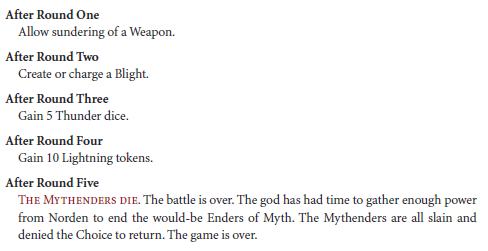 Sundering lets a Greater Myth destroy one of their Weapons to get immediate token and dice gains, and more benefits are gained from Sundering Weapons with more undrained charges. But we don’t care about that, really, since the bigger deal is that time limit. After round five, THE MYTHENDERS DIE, no reviving allowed. Playing to a standstill is just fine for the Myth, since their real power just takes some time to bring to bear. This is the only way in which a Myth can actually, fully kill a Mythender, so the Mythenders are free to use all the power they can get to put down the Myth quickly. Note that this also means that a Lesser Myth cannot kill off a Mythender- though they can get them to Apotheosize. They’d have to be really lucky or a fair bit stronger than average to make that a serious risk, though. Next up, we get a bunch of Greater Myths, in order from easiest to hardest. Unfortunately, as we don’t get as much as a picture for any of these (or the Lesser Myths, for that matter), unless you count Odin’s head in a few other places. It’s noted elsewhere throughout the book that almost all of the Greater Myths are not the originals- Odin in particular has been “slaughtered countless times-” but some poor one-eyed Mythender gets up to too much order and foresight and soon ends up taking his place. It never gets stated in the book, but since the gods get more powerful with each cycle of Apotheosis and keep getting taken out, the originals probably went down like chumps. That, or the Mythenders get more powerful in kind. First is Thor. He’s pretty basic, meant to be the first God a newbie group would fight. If you want to fight something else, the book suggests using his stats and just changing the weapon names. Each Greater Myth also gets a half page of their deeds, motivations, temperament, and what they think of Mythenders. In Thor’s case, he enjoys Mythender battles in the usual finally-a-worthy-fight fashion. Odin is the guy who gets pissy when his carefully-laid plan to dominate the natural order gets stomped on, so he sets off to try to bring Mythenders back into line. It’s fine to battle monsters and giants, but killing off Aesir is just not part of the deal. He’s a straight upgrade from Thor in power, having *every* base gift and a few upgrades. That’s 17 gift slots, so he’s not exactly playing by the rules. As the book loves to note, the Myths are “cheating bastards.” Still, the sheer amount of Might tokens required means he can’t use all of those at once; he’s just got options. Freyja gets to be the “Goddess of Motherhood and Lust.” Other domains are love, fertility, life, war, and death. Quite a range she has there. She has a lot of bewitched thralls, and her style of fighting is to tempt people into corruption, rather than wounding them physically. Her devotees take care of the bloody parts for her. Freyja’s Gathering Rage gets the addition of progressing Mythender corruption at the end of each round (I think the whole party, but it’s unclear). If the time limit is reached and you’ve got a full Corruption track, you Apotheosize instead of dying. Loki’s up next, and he gets a fun bit in his description I’ll quote: quote:Loki is nothing less than Norden’s spirit of all that is wild, and as such is not bound to form or nature. He is the master, and perhaps mother, of all magic in the land. Through his loins he forges many of Norden’s untamable beasts... I don’t even know where this weird-rear end style is coming from. He also likes to steal other Myths’ artifact weapons just to see how well he can smack around Mythenders with them. He sees Mythenders as kin in their wild nature, being between Myth and mortal, but befouled by their eventual fall one way or another. In combat, he’s got a huge Might recharge of 15, the highest in the default stats, so he’ll be getting suitably tricky with his Gifts. Loki also has a slightly more favorable Wound track than the prior gods, so he’ll keep a bit more of his power for longer. Jormungandr, the World Serpent, is a bit crazy. It’s got a whole purity complex, refusing to even speak due to the impurity of words or something, and its blood will poison and burn away anything unrighteous. It fights alone, so its Companion weapons are its dominion- the sea, sky, and its own nigh-endless coils. The main complication is, like Freyja, the Gathering Rage track. Twice, it gets to wound the Mythenders for free, and THE MYTHENDERS DIE happens after round *four.* Yeesh. Finally, Fenrir the Unstoppable Wolf shows up. Noted as one of the first results of Mythender apotheosis, he’s a castle-sized ball of fur and hate. He also Ended Tyr, one of the few half-decent Aesir gods. He hates mortals for their lack of volition, himself for falling in the first place, and Mythenders for going along with the cosmic joke of their Corrupted existence. He “just wishes battle with Mythenders to be over quickly, so he may go back to his revenge.” He doesn’t have much better stats overall than Jormungandr, but he gets to use the Grievous Harm gift (makes wounds hit harder) at base level for free, so you’re much more likely to be fighting with very few resources at hand or blowing a lot of tokens on softening the blow. After that list, we get some words on making your own Myths. They should be iconic, an individual being or otherwise special- if you’re going to kill a dragon, either establish a named Dragon like Smaug or make it The Dragon, as in the very Platonic conceptual ideal of dragonkind. Media, real-world myths, and *other RPG sourcebooks* are noted as good inspirations. GURPS gets a shout-out. More powerful Myths can be made with more double-type Weapons, extra gifts, or tweaking up the stat numbers. They also suggests adding some bleedover Myths from elsewhere, possibly in refuge from other Worlds that were Ended wholesale- it could be fun to fake out the party by having Hel get beaten down in the first round, only to have Hades tag in. There’s an example Norden adventure with the default Einherjar-Thor duo, set around a warrior fort-village that worships Thor. The inhabitants, terrified at the fallen Valhallan warriors and suffering from whatever Blights the first fight leaves, pretty much think they may as well be dead. They love and praise Thor, so they mostly plead with the Mythenders to just please go away and stop destroying the world as they know it. If Thor eats it, they either get mindwiped to worship the Mythenders if they Terrorized the mortals, or else start to realize they’ve been freed, and are thankful despite their earlier reaction. Speaking of the default fights, Next time: The very silly, overlong Tutorial battle (prepare for many quotes)
|
|
|
|

|
| # ? Apr 26, 2024 08:57 |
|
i hate mythenders so much
|
|
|


































